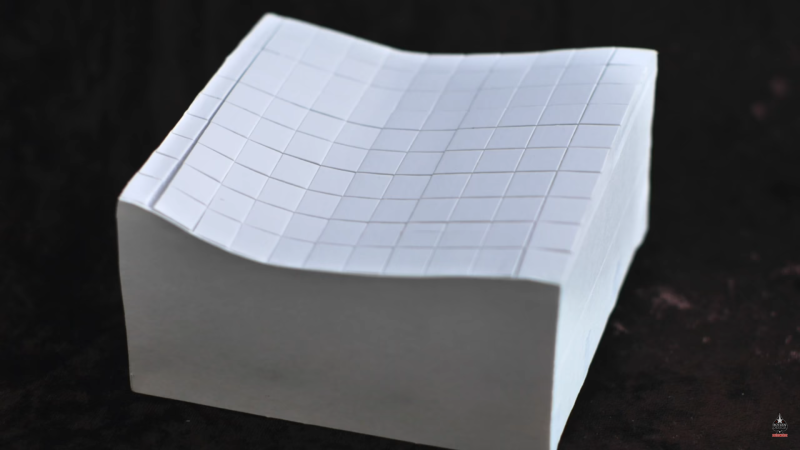Some of our pastimes are so deeply meditative that we lose ourselves for hours. Our hands seem to perform every step, and sequence like a pianist might recite her favorite song. If [Eric Strebel]’s voice and videos are any indications, working with foam core can have that effect.
Foam core is a staple of art stores, hobby stores, and office supply stores. It comes in different colors, but the universal trait is a sheet of foam sandwiched between a couple of layers of paper. This composition makes a versatile material which [Eric] demonstrates well in his advanced tutorial making a compound surface and later on a speaker mockup.
After the break, you can catch a couple of beginner tutorials which explain the differences between a slapdash foam core model, and one which will draw appreciation. Proper tools and thoughtful planning might be the biggest takeaways from the first two videos unless you count the Zen narration. The advanced videos, linked above, show some ingenious ways to use foam core like offset scoring, adjustable super-structures, and paper transfers.
Each video is less than ten minutes long, so if you just started your coffee break, you can complete a video right now. Or look at another 2D material turned into amazingness with a papercraft strandbeest, then step up your game with another look at vinyl cutters.















Why bother when you can just 3D print the bloody thing.
It might teach you something 3d printing won’t. Having a robot to do it for you is handy, but it also has a stagnating effect. It’s best to use different methods from time to time.
off the top of my head for many things this is quicker still, more energy efficient, less toxic fumes and it can be done anywhere without the need of either a computers or electricity…..
plus at the end of the day there is also the fact a foam core model is easier to get ride of then a plastic 3d printed one.
This is consideraby faster
In another video, he talks about making a model adjustable since he didn’t know the end size. If done on the computer, you can’t get a feel for size at all until after the first print, so depending on the need, this really is quite faster. 3D design and printing is great, and so is foamcore. Both are good tools to have for similar and different purposes.
https://youtu.be/rkqZ29PjZ-k
Foam core is light weight and can be used to make flying things because it’s strong and light. It’s also good in some costume applications also because of it’s light weight.
Oi, that’s a lot of low-precision effort! Call me when there’s a program that decomposes 3d models and exports gcode for a CNC so that all I have to do is fold and glue.
Respect the old ways. Hands are very capable little cnc machines.
Wrinkly, arthritic, CNC machines.
this thought right here is how craftsmanship dies.
Pepakura will get you close to that.
I know about it mostly from Flite-test’s foamboard planes.
Interesting material, with some care you can laser cut it well and make very accurate shapes.
same here
+2
Good video though.
Definitely not for fans of FliteTest (-;
Missed the part when he explains how to do accurate 45deg cuts
That’s because he didn’t. Which is frustrating, since that was the actual important part.
I think the only secret there is practice.
10,000 Hours http://www.bbc.com/news/magazine-26384712
hold the ruler back edge an equal amount to the foam cores thickness and you get a 45deg cut. i.e. 1/4 inch foam 1/n inch back and so on
“Some of our pastimes are so deeply meditative that we lose ourselves for hours. ”
Origami.
My cutting tool of choice is a scalpel with #11 blade. Perfect for foam core and many other apps in electronics, etc.
Good idea! Some quick searching shows you can get packs of 100 blades with a free handle for like five bucks. They seem to have the same profile as an xacto 11, just way cheaper.
And I’ve always hated xacto’s blade-locking mechanism with a firey passion. Always gets sloppy, slips out or wiggles back and forth, and the soft metal threads soon get mangled by over-tightening to compensate. Or is my personal lack of finesse to blame? To be honest, that’s a strong possibility.
I assume scalpels have a better mechanism by the virtue of cutting on people instead of model airplanes. Definitely don’t want the blade to slip off and get lost in there. What do you think?
All these techniques can be almost perfectly transferred to balsa wood FYI. Fun stuff.
“Hot glue is for hacks”
Its always a bummer when people make disrespectful blanket statements about a material/technique.
As for the scalpel it does lock onto the handle and will not come loose. Plus several different styles of blades, at least two kinds of handle and small and large sizes for the blades. Considered the world’s 3rd sharpest edge.